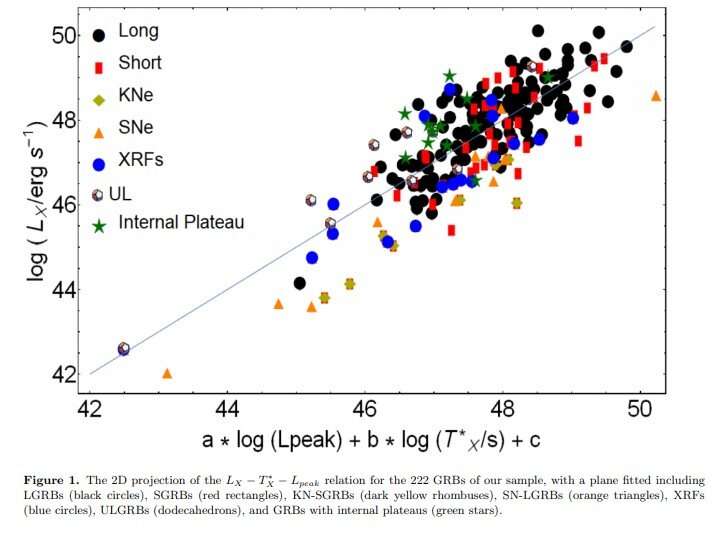Kilonovae: Ambushing the standard candle in its own nest

Gamma-ray bursts (GRBs) are the most luminous and explosive transient phenomena in the universe after the Big Bang. A powerful tool for characterizing and classifying GRBs to allow them to be used as tracers of the expansion history of the universe and to understand their mysterious and debated physical mechanisms has been recently presented by an international team of researchers led by Dr. Maria Dainotti, assistant professor at Jagiellonian University, Poland. The new article, which has been accepted by the Astrophysical Journal, is a statistical analysis of the properties of the mysterious GRBs, aimed at determining the observational properties of GRB subclasses. The article pays particular attention to the GRBs associated with kilonovae.
Astronomers can only directly measure distances to objects that are close to Earth and must extrapolate the distances to objects farther out. All the objects that serve as rungs on the cosmological distance ladder have known luminosities and are referred to as "standard candles." Once the absolute luminosity of the standard candle is known, the distance to that object can be calculated based on its measured brightness. For example, the light of the same standard candle will appear dimmer when it is farther away. GRBs are so powerful that in a few seconds, they emit the equivalent of the energy emitted by the sun during its entire lifetime. Thus, it is possible to observe GRBs at incredibly large distances (a.k.a., high redshift), much further than standard candles like Ia-type supernovae (SNe Ia) that are observed at up to 11 billion light-years. Using GRBs as a new type of standard candle will allow astronomers to study and comprehend cosmological issues that could change current models regarding the universe's history and its evolution.
Despite decades of observations, a comprehensive model able to explain the underlying physical mechanisms and properties of these objects has not been reached yet. Many possible physical origins for GRBs have been proposed, like the explosion of an extremely massive star (the long duration GRBs) or the merging of two compact objects (the short-duration GRBs).
Kilonovae (KNe) are astrophysical objects linked to GRBs that last less than two seconds. These short GRBs come from explosions after the fusion of two compact objects such as neutron stars (NS). The detection of X-ray emission at a location coincident with the KN transient can provide the missing observational link between short GRBs and gravitational waves (GWs) produced by NS mergers. The first detection of the KN associated with GW and the short GRB 170817 has opened a new era of observations and theoretical investigation. The missing piece to this longstanding story is the connection of KNe and the GRB observational correlations that Dainotti et al. now provide.
Even when all the GRBs are observed with the same satellite, in this case, NASA's Neil Gehrels Swift Observatory, the features of GRBs are seen to vary widely over several orders of magnitude. This applies not only to the prompt emission (the main event in the gamma rays), but also to the extended afterglow phase (which follows the prompt emission and is seen over a wide range of wavelengths). Thus, the key point of the article by Dainotti et al., is the hunt for features that remain invariant according to peculiar classes of GRBs.
The team has found a 3-D correlation, i.e., a link between the following three variables that identifies a plane: duration of the X-ray plateau phase, its luminosity, and the luminosity of the peak prompt gamma-ray feature. The distances of GRBs from the plane of a given class allowed the authors to determine if GRBs belong to that particular class by showing different features related to this 3-D correlation. Dainotti et al. also show that although the GRBs-KNe events are a subsample of the larger class of short duration GRBs (red cuboids), they show some observational peculiarities: Indeed, they all lie below the short fundamental plane as shown in Figure 1 (yellow truncated icosahedrons).
In this analysis, selection biases and evolutionary effects (namely, how the variables change with distance or redshift) have been accounted for and have shown that the fundamental plane pinpointed by kilonovae is reliable and it is independent from selection effects; thus, future application of this plane as a cosmological tool is possible. In fact, the GRBs-KNe plane has the smallest observed distance from its plane, called the intrinsic scatter. Here this scatter is 29% smaller than a previous analysis, see Fig. 1, which was from a NASA press release in 2016. We note that this finding has been reached in a natural way without assuming any observational criteria as had been done in previous studies performed by some of the authors in this research. This new result is thus a step much further ahead than previous analyses.
We note here that all the KN-SGRBs (marked in yellow) fall below the best fitting plane. In addition, the GRBs associated with KNe plane still has a very small distance from the respective kilonovae plane when evolution is accounted for, see Fig. 2. The smaller the distance is from the plane, the more useful the plane is to be used as a cosmological tool. A great advantage of using the GRBs associated with kilonovae is that the GRBKNe events have a clearer physical emission process compared to other observational GRB classes.
Thus, the leap forward in this study is that this sample has a physical grounding related to the fundamental plane relation regardless of the features of the plateau phase which can vary widely from one GRB to another.
More information: The X-ray fundamental plane of the Platinum Sample, the Kilonovae and the SNe Ib/c associated with GRBs. Astrophysical Journal (2020). DOI: 10.3847/1538-4357/abbe8a
ArXiv: arxiv.org/abs/2010.02092
Journal information: Astrophysical Journal
Provided by Space Science Institute





















